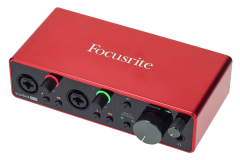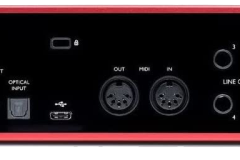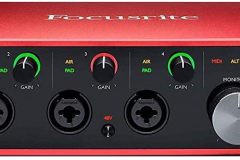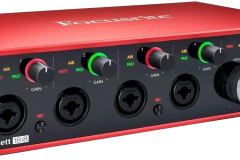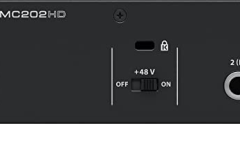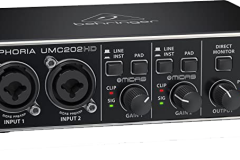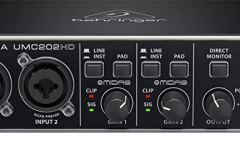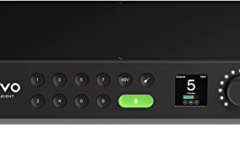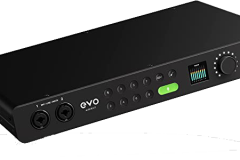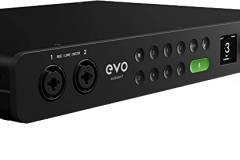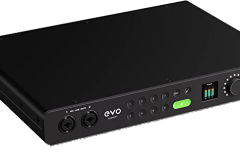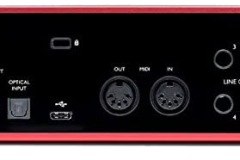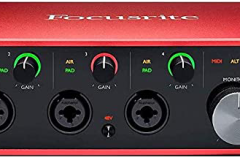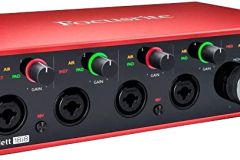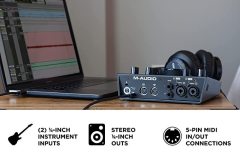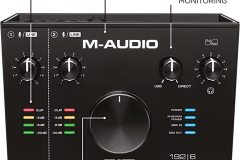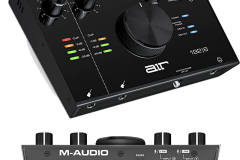When it comes to recording and playing guitar through your laptop or computer, having a reliable USB audio interface is essential. With the sheer number of VSTs out there, the ability to connect your guitar to your computer is critical. These devices act as the bridge between your guitar and the digital realm, providing high-quality sound and versatile connectivity options.
In this guide, we will explore five of the best USB audio interfaces specifically designed for guitarists, from easily accessible budget options to higher end specced interfaces. Join us as we dive into the pros and cons of each product and highlight their key technical features.
What we’ll cover
- What is an audio interface?
- Types of audio interfaces
- Choosing an audio interface
- Why do you need one?
- Our top 5
- Final Thoughts
What is a USB audio interface?
An audio interface is a device that allows you to connect your microphones, instruments, and other audio gear to your computer. It acts as a bridge between your analog audio gear and your digital audio workstation (DAW).
Audio interfaces typically have two main types of connections: input and output. Input connections allow you to connect your microphones, instruments, and other audio sources to your interface. Output connections allow you to connect your interface to your speakers, headphones, or other audio playback devices.
Audio interfaces also typically have a number of other features, such as:
- Preamps: Preamps amplify the signal from your microphones, making them louder and easier to record.
- A/D converters: A/D converters convert the analog signal from your microphones and instruments into a digital signal that can be stored on your computer.
- D/A converters: D/A converters convert the digital signal from your computer back into an analog signal that can be played through your speakers or headphones.
Types of audio interfaces
There are many different types of audio interfaces available, each with its own set of features and price points. Some of the most common types of audio interfaces include:
- Desktop interfaces: Desktop interfaces are the most common type of audio interface. They are typically small and easy to use, making them a good option for home studio setups.
- Rackmount interfaces: Rackmount interfaces are designed to be mounted in a rack. They typically offer more features and connectivity than desktop interfaces, making them a good option for professional studios.
- Portable interfaces: Portable interfaces are designed to be taken on the go. They are typically small and lightweight, making them a good option for musicians who travel frequently.
Choosing an audio interface
When choosing an audio interface, there are a few things you’ll need to consider:
- Your budget: Audio interfaces can range in price from a few hundred dollars to several thousand dollars. It’s important to set a budget before you start shopping so that you don’t overspend.
- Your needs: What type of audio gear do you plan to connect to your interface? If you only plan to connect a few microphones, you won’t need an interface with a lot of inputs. However, if you plan to connect a variety of audio gear, you’ll need an interface with more inputs.
- Your features: What features are important to you? Some audio interfaces offer features such as built-in preamps, A/D converters, and D/A converters. If these features are important to you, be sure to choose an interface that has them.
Once you’ve considered these factors, you’ll be able to choose the right audio interface for your needs.
Why do you need one?
Here are 3 reasons why every guitarist should consider using a USB audio interface.
- Guitar Plugins: In recent years, there has been an explosion of digital audio workstation (DAW) plugins for guitar. These plugins offer a wide range of features, from virtual pedalboards and amps to learning apps, recording platforms, and sound banks. With DAW plugins, guitarists can now access a vast array of tones and effects that were once only available to professional musicians. For example, guitarists can now plug into any amp or pedal from any era of history, or get personalized lessons for any song they can think of.All you need to take advantage of these plugins is a capable audio interface. An audio interface is a device that allows you to connect your guitar to your computer. Once you have an audio interface, you can download and install the plugins you want to use.
- Recording: Connecting your guitar to your computer allows you to record, using a digital audio workstation (DAW), your playing. So if you are considering laying down some tracks for a record, or for social media for example you’ll need a USB audio interface. Sometimes even just listening back to your own playing can be helpful for learning.
- Learning: There are so many guitar courses courses online, YouTube backing tracks, songs etc. and you can play along to those through your USB audio interface. Playing alongside this music is one of the main reasons to get a USB audio interface.
Right, that’s enough of the background, let’s get into our top 5 USB audio interfaces for guitarists.
Focusrite Scarlett 2i2 3rd Gen USB Audio Interface

The Focusrite Scarlett 2i2 has become a household name among musicians and audio professionals. With its 3rd Gen update, this compact audio interface offers an impressive combination of quality and affordability. Key features include:
- Excellent audio quality with Focusrite’s renowned preamps.
- Solid build quality and intuitive design.
- Low-latency performance for seamless recording and monitoring.
- Two XLR inputs with phantom power for condenser microphones.
- Balanced outputs for studio monitors.
Behringer U-Phoria UMC202HD

The Behringer U-Phoria UMC202HD is a budget-friendly audio interface that doesn’t compromise on quality. It offers a range of features perfect for guitarists on a tight budget. Here’s what you can expect:
- Affordable price without sacrificing sound quality.
- Two Midas-designed preamps for clean and transparent audio.
- 24-bit/192kHz resolution for high-fidelity recordings.
- Zero-latency direct monitoring for hassle-free recording sessions.
- Durable metal construction.
Audient EVO 16 USB Audio Interface

The Audient EVO 16 stands out with its user-friendly design and exceptional audio performance. It offers a perfect balance between simplicity and professional-grade features, making it a great choice for guitarists at any skill level. Key features include:
- Transparent and pristine audio quality.
- Smart gain feature for easy and precise gain setup.
- Intuitive single-knob control for quick adjustments.
- JFET instrument input for direct guitar connection.
- Loopback functionality for hassle-free streaming.
Focusrite Scarlett 18i8 3rd Gen USB Audio Interface

If you require more inputs and outputs for your recording needs, the Focusrite Scarlett 18i8 is a versatile option. It offers a comprehensive set of features that caters to both guitarists and producers. Here’s what it brings to the table:
- High-quality Focusrite preamps for exceptional audio fidelity.
- Flexible I/O configuration with four mic/line inputs and four line outputs.
- MIDI connectivity for seamless integration with MIDI controllers and instruments.
- Excellent software bundle included (Ableton Live Lite, Pro Tools First, etc.).
- Low-latency performance ideal for real-time effects and monitoring.
M-Audio AIR 192×6 USB C MIDI Audio Interface

The M-Audio AIR 192×6 is a feature-packed USB audio interface tailored for guitarists, podcasters, and streamers. With its comprehensive connectivity options and robust build quality, it offers a solid foundation for professional recordings. Key features include:
- High-resolution 24-bit/192kHz audio quality.
- Two XLR/TRS combo inputs with Crystal preamps.
- Four additional ¼” line inputs for versatile recording setups.
- Dedicated MIDI I/O for connecting MIDI devices.
- USB-C connectivity for fast and reliable data transfer.
Final thoughts
The rising popularity of audio interfaces among guitarists is undeniable. With their numerous benefits and advantages, it’s no wonder that more and more guitarists are incorporating them into their workflow. If you’re eager to join the ranks and enhance your guitar playing experience, it’s crucial to find the right audio interface that suits your specific needs.
By reading through this article, you’ve already taken a significant step towards discovering the perfect audio interface for your guitar. Armed with the knowledge and insights shared here, you now have a solid foundation to make an informed decision. So, get ready to dive into the world of audio interfaces and unlock the full potential of your guitar-playing journey.


